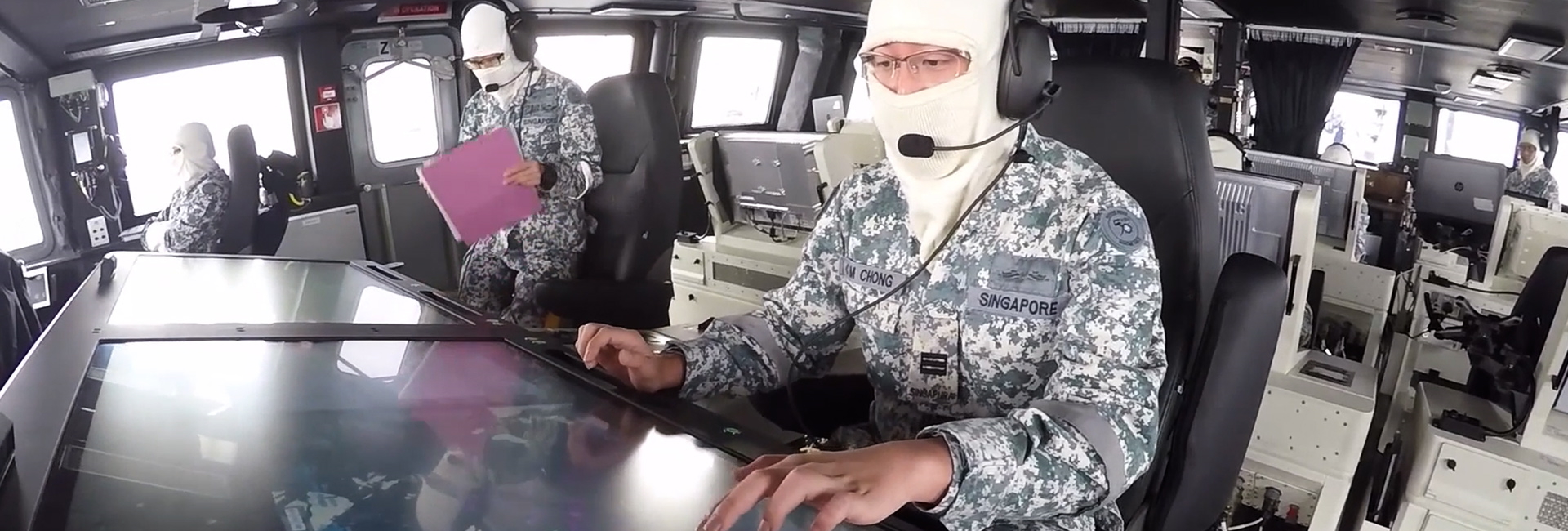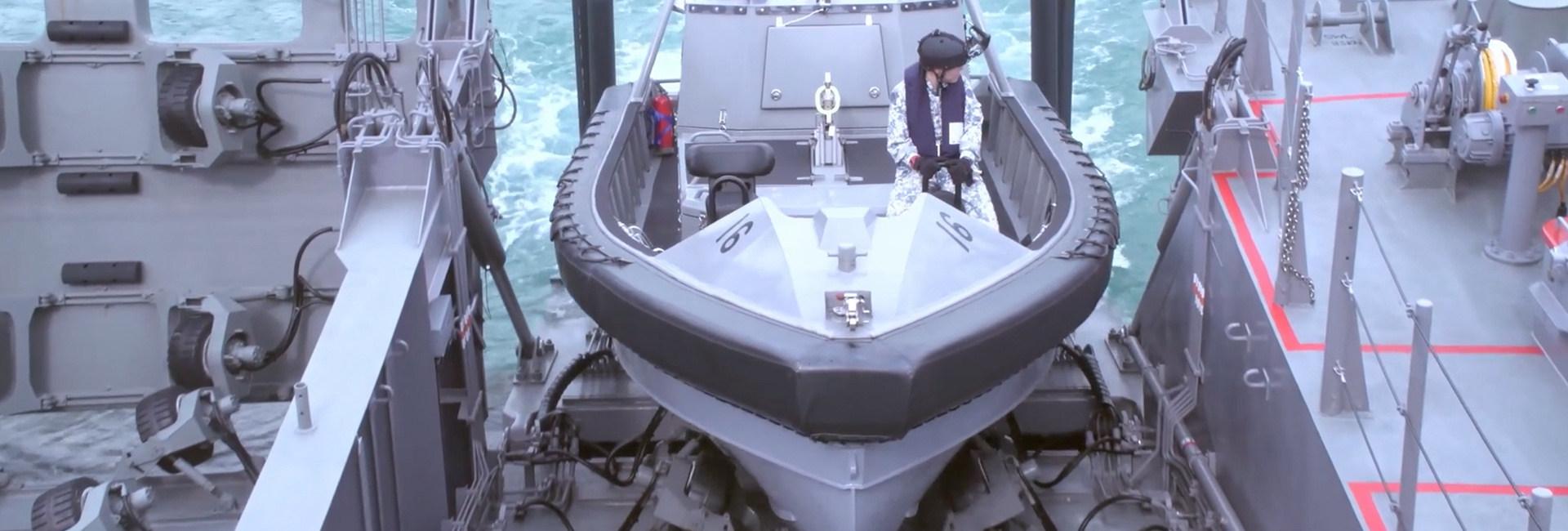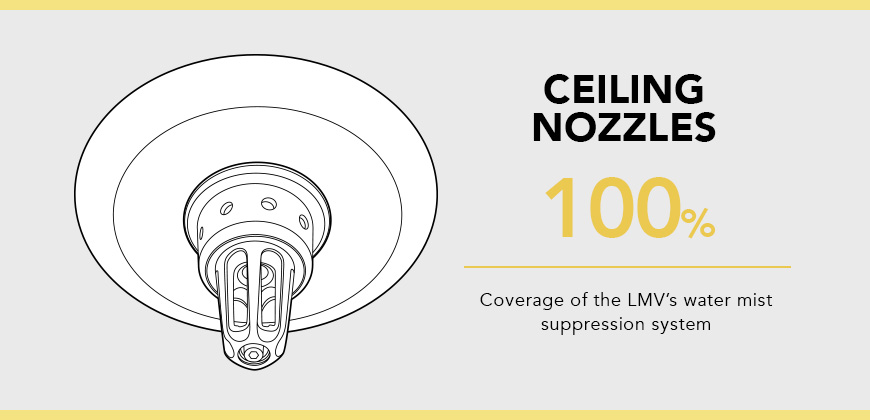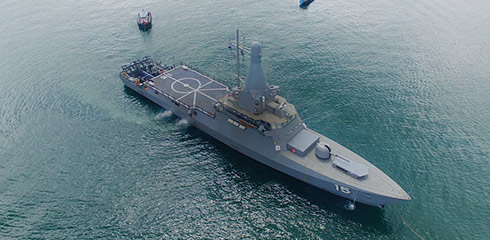Hundreds of kilometres from home base, LMV Independence is a solitary grey ship, slicing across South China Sea for the first time ever.
Aboard this new vessel, the crew is buzzing with excitement. They might have spent months getting familiar with their new vessel in harbour and the nearby Singapore Strait, but the real test for the LMV’s seaworthiness and mission readiness begins now.
And much is at stake. If the LMV performs poorly in any of the trials over the next few days, it might necessitate redesign, retraining and refitting — taking months. As the LMV would boost the Republic of Singapore Navy’s (RSN) ability to tackle maritime security threats, there is a tight deadline to meet and no room in the vast sea for missteps.
And so, under the watchful eyes of checklist-armed examiners from both the Republic of Singapore Navy (RSN) and the Defence Science and Technology Agency, the crew set out to prove the LMV’s mettle.
A Real Head-turner
At the LMV’s Integrated Command Centre (ICC), Executive Officer MAJ Eileen Sow confirms the ship’s bearings, relaying its status to headquarters as the sky begins to darken.
The LMV was facing a rougher sea, but when the helmsman pulls the throttle, the LMV slices through the increasingly choppy waters as if it were sailing on calm seas. Even at maximum tonnage, the ship hit its maximum speed of more than 27 knots in a matter of seconds.
Furthermore, the acceleration is so effortless and the seakeeping so smooth that she has to do a double take on the ship’s instruments to make sure that the LMV is indeed running at maximum torque.
After obtaining engine readings from ME2 Kesavan, Commanding Officer LTC Tay Choong Hern orders a “crash stop” to test the LMV’s ability to make sudden halts. The crew braces themselves in their seats, but deceleration takes hardly any time at all. Independence decelerates from 27 knots to zero in less than 10 seconds — an incredible timing for ships of the LMV’s size and weight.
The next test of the LMV’s manoeuvrability sees the ship making a tight clockwise turn. “Hard to starboard. Hard to starboard,” the helmsman announces. Although the LMV is designed with a small turning diameter, executing tight turns in rough seas is always risky, as a lesser ship could risk capsizing.
As the LMV executes the turn with barely any fuss, ME2 Kesavan marvels at how the ship, despite being larger and heavier than earlier Fearless-class patrol vessels, manages to execute the extreme manoeuvre so nimbly. “Being a propeller ship instead of a water jet ship, I initially thought this ship would take some time to turn when doing a hard-to-port or hard-to-starboard. But it is super fast, and can even turn almost on the spot.”
In the busy Singapore Strait, this agility is critical. LTC Tay uses the example of the LMV pursuing a rogue speedboat weaving in between container vessels and oil tankers. “Without being able to make sharp and quick turns, a small target like that could be easily lost.
All Guns Blazing
Naval ships, however, aren’t made for just manoeuvrability. The LMV must ace a series of trials to prove it really is smarter and sharper than its predecessor. All warships must carry firepower, and this one is no different. The LMV is fitted with calibres ranging from 12.7mm to 76mm to handle a wide variety of threats in both Singapore’s littoral environment and the open sea.
What sets the LMV apart is the ship’s high-resolution, 360-degree electro-optics system. The camera system lets the crew easily track small objects and vessels, even in high sea states or at night.
During gun firings out in open sea, the LMV produces stellar results – the radar detects the targets, the guns are well-calibrated, and the LMV blows this test out of the water, literally. Nothing escapes the LMV’s crosshair, not even the distant, barely visible mock “target” .
The Tools of Survival
Beyond warfare, the LMV is also well-equipped for other operations, such as Search-and-Rescue (SAR) and boat operations. And the LMV pulls off such operations with great speed – time often being of essence in SAR operations.
During the man overboard drill, a life buoy is tossed into the sea to simulate a target in the water. “Man overboard, man overboard, man overboard. Man overboard starboard side!” The alarm is raised, and the rescue team races to gear up.
The LMV carries up to two grey aluminium Rigid Hull Boats (RHBs). At the press of a button, the ‘friction wheel’ mechanism underneath the docked RHB activates – launching the multi-tonne RHB into the water in one minute, compared to a slow 30 minutes by winch line. It will haul the RHB back onboard in the same amount of time. “This is the first system in the world whereby we do not require a winch line to pull back the boats,” LTC Tay says proudly.
The mechanism performs beautifully during the drill, and the lifebuoy is “rescued”.
An Intelligent Machine
So far, the LMV has sailed through multiple tests smoothly – manoeuvrability, weapons firing and boat operations, just to name a few. How will it take on what is traditionally a sailor’s worst fear?
“Fire fire fire! Fire at ER2 starboard side. Water mist activated.”
The LMV incorporates a high degree of automation – so much so that no crew is required to put out the “fire”. While ME2 Kesavan and the other crew don their firefighting gear, it is more of a precaution. Furthermore, familiarity with the firefighting and damage control manoeuvres is essential for wartime scenarios where the LMV will be constantly at risk of attacks.
In this drill, the “fire” is put out from the ICC. Operations Officer MAJ Eileen visually identifies the source of the “fire” via the ship’s network of high-definition close-circuit cameras. With a few swipes and clicks on the Command Console, she activates electronic smoke boundaries that extract oxygen from the affected area. At the same time, ultra-fine mists of water descend from ceiling nozzles, putting an end to the simulated mayhem.
The examiners may have yet to utter a word, but the fact that Kesavan doesn’t even break a sweat means the crew must be doing something right.
Homeward Bound
After many gruelling days of sea trials, the LMV Independence is programmed for a homeward course. The helmsman steps back as the automated navigation system takes over to keep the vessel on its assigned path. Earlier in the trials, the autopilot, assisted by navigational radar, far outperformed its rated accuracy of 20 metres — never deviating past ten.
With the Singapore flag hoisted at its bow, the LMV Independence returns home to Tuas Naval Base to cheers of naval personnel on the concrete docks. Now, they just have to wait, and see if they have passed their stringent acceptance tests. Only then can the LMV be proved mission-ready.















